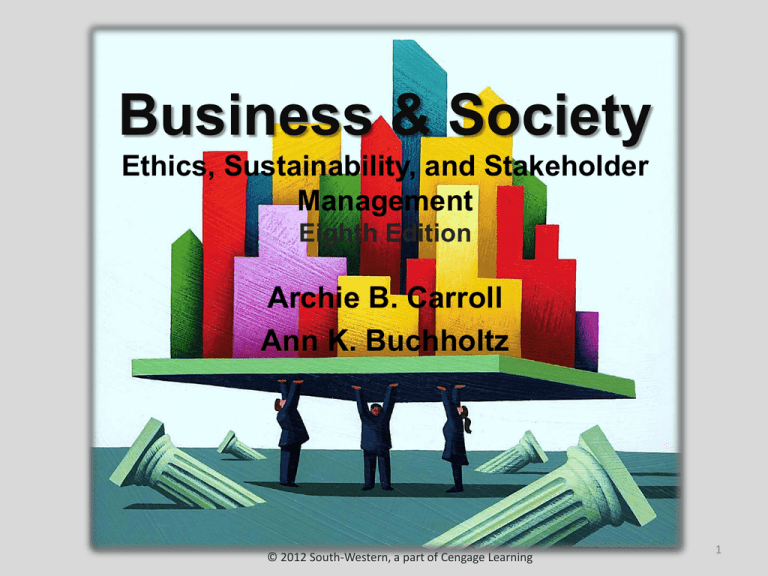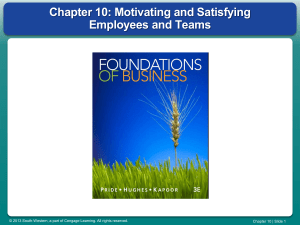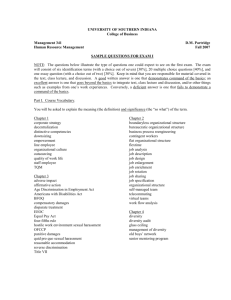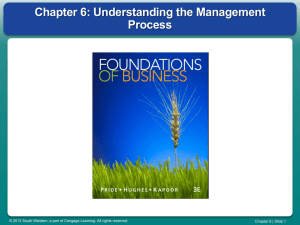
Business & Society
Ethics, Sustainability, and Stakeholder
Management
Eighth Edition
Archie B. Carroll
Ann K. Buchholtz
© 2012 South-Western, a part of Cengage Learning
1
Chapter 19
Employment
Discrimination
and Affirmative
Action
© 2012 South-Western, a part of Cengage Learning
2
Learning Outcomes
1. Chronicle the U.S. civil rights movement and minority
progress for the past 50 years.
2. Outline the essentials of the federal discrimination laws.
3. Provide two different meanings of discrimination and give
examples of how each might be committed.
4. Elaborate on issues in employment discrimination relating to
race, color, national origin, sex, age, religion, sexual
orientation, and disability.
5. Identify different postures with respect to affirmative action,
explain the concept of reverse discrimination, and provide an
overview of the Supreme Court’s decisions on affirmative
action.
© 2012 South-Western, a part of Cengage Learning
3
Chapter Outline
• The Civil Rights Movement and Minority Progress
• Federal Laws Prohibiting Discrimination
• Expanded Meanings of Employment Discrimination
• Issues in Employment Discrimination
• Affirmative Action in the Workplace
• Summary
• Key Terms
© 2012 South-Western, a part of Cengage Learning
4
Protected Groups
Protected groups
• Those who have federal-level legal
protection from discrimination based on
race, color, religion, national origin, sex,
age, or disability.
“Protected” groups are not protected from
job loss: young minority men bore a
disproportionate burden of the layoffs in
the most recent recession.
© 2012 South-Western, a part of Cengage Learning
5
Civil Rights Movement
• 1995: Rosa Parks refused to give up her
bus seat.
• 1964: The Civil Rights Act was the
effective beginning of the employee
protection movement.
•
The 1970s: The Women’s Movement
•
The 1980s: Gains for women and blacks
•
The 1990s: Some progress, but problems
remained
•
The 21st century: New challenges and old
problems
© 2012 South-Western, a part of Cengage Learning
6
Federal Anti-Discrimination Laws
Title VII of the Civil Rights Act of 1964: Prohibits discrimination in hiring and
other aspects of employment on the basis of race, color, religion, sex, or national
origin.
Age Discrimination in Employment Act of 1967: Protects workers 40 years old
and older from arbitrary age discrimination.
Equal Pay Act of 1963: Prohibits sex discrimination in payment of wages to
women and men who perform substantially equal work.
Rehabilitation Act of 1973, Section 503: Prohibits job discrimination on the basis
of a handicap.
Americans with Disabilities Act of 1990: Gives individuals with disabilities civil
rights protections similar to those given to individuals on the basis of race, sex,
national origin, and religion.
Civil Rights Act of 1991: Provided increased financial damages and jury trials in
cases of intentional discrimination.
© 2012 South-Western, a part of Cengage Learning
7
Title VII of the Civil Rights Act of
1964
Under Title VII, it is illegal to
discriminate in:
•
•
•
•
•
•
•
•
•
•
•
Hiring and firing
Compensation, assignment, or classification of
employees
Transfer, promotion, layoff, or recall
Job advertisements
Recruitment
Testing
Use of company facilities
Training and apprenticeship programs
Fringe benefits
Pay, retirement plans, and disability leave
Other terms and conditions of employment
© 2012 South-Western, a part of Cengage Learning
8
Age Discrimination in Employment
Act of 1967
• Protects workers 40 years old and older
from:
•
•
•
•
•
•
Arbitrary discrimination in hiring
Discharge
Pay
Promotions
Fringe benefits
Other aspects of employment
Does not apply where age is a bona fide
occupational qualification (BFOQ)
•
When a company can legitimately argue that
younger age is necessary and related to the
position.
© 2012 South-Western, a part of Cengage Learning
9
Equal Pay Act of 1963
• Prohibits sex discrimination in payment of
wages to women and men who perform
substantially equal work in the same
establishment.
• Attention was revived in 2007 with the
Ledbetter v. Goodyear Tire & Rubber Co.
case.
•
•
Lily Ledbetter alleged she had been paid less
than males for equal work.
In 2009, The Lily Ledbetter Fair Pay Act undid
a Supreme Court decision that there is a 180
day statute of limitations on discriminatory
pay charges.
© 2012 South-Western, a part of Cengage Learning
10
Americans with Disabilities Act
An individual with a disability:
• Has a physical or mental impairment that
limits one or more major life activities.
• Has a record of such an impairment.
• Or, is regarded as having such an impairment.
Reasonable accommodation may include:
Accessible facilities
Job restructuring, work schedule modification,
reassignment
Acquiring or modifying equipment or devices;
making adjustments to examinations;
providing training materials, readers, or
interpreters
11
© 2012 South-Western, a part of Cengage Learning
Americans with Disabilities Act
(continued)
The ADA is a work in progress
• 2003: The EEOC restricted the definition
of a disability.
•
An impairment is a disability only if it
“substantially limits one or more of the employee’s
major life activities (speaking and interacting with
others, learning, thinking, concentrating, and
working).
• 2008: Amendment broadened the
definition of disability again.
•
The existence of mitigating factors and a
disease being episodic or in remission are no
longer exclusionary factors.
© 2012 South-Western, a part of Cengage Learning
12
Equal Employment Opportunity
Commission
Equal Opportunity Commission (EEOC)
• Has five commissioners and a general
counsel
• President appoints and Senate confirms
• Purpose:
• Makes equal employment opportunity policy
• Investigates employment discrimination
charges/complaints
• Enforces anti-discrimination laws through
conciliation or federal lawsuits against
employers
© 2012 South-Western, a part of Cengage Learning
13
Expanded Meaning of Employment
Discrimination
Disparate treatment
•
Using race, color, religion, sex, or national origin
as a basis for treating people differently or
unequally.
Disparate impact
•
Fewer minorities are included in the outcome of
testing, hiring, or promotion practices than would
be expected by numerical proportion.
Four-fifths rule
•
If a member of a minority group does not have a
success rate at least 80 percent that of the majority
group, the practice may be considered to have an
adverse impact.
© 2012 South-Western, a part of Cengage Learning
14
Employment Discrimination
Disparate Treatment
Disparate Impact
Direct discrimination
Indirect discrimination
Unequal treatment
Unequal consequences or results
Decision rules with a
racial/sexual premise or cause
Decision rules with
racial/sexual consequences or results
Intentional discrimination
Unintentional discrimination
Prejudiced actions
Neutral, color-blind actions
Different standards for different groups
Same standards, but different
consequences for different groups
© 2012 South-Western, a part of Cengage Learning
15
Issues of Racial Discrimination
Race discrimination
• Discrimination on the basis of ancestry or
physical or cultural characteristics
associated with race (skin color, hair
texture or styles, or certain facial features).
African Americans
• The number with seats on Fortune 500
boards is declining.
• High barriers to professional achievement.
© 2012 South-Western, a part of Cengage Learning
16
Issues of Racial Discrimination
(continued)
Hispanics
• Highly diverse population from many
countries and different races.
• Dramatic population growth in the U.S.
• Worsening political and employment climate
for Latinos/Hispanics in U.S.
Asian Americans
• Have a possibly excessively positive
stereotype as smart, disciplined, and good at
math/sciences.
• Bimodal distribution: group of high-paid
professionals and one of low-skilled and
disadvantaged workers.
• Not well represented on Fortune 500 boards.
© 2012 South-Western, a part of Cengage Learning
17
Issues of Sex Discrimination
Major issues for women
1. Getting into professional and managerial
positions and out of traditional femaledominated positions.
2. Achieving pay commensurate with that of
men.
•
Comparable worth: Workers doing different
jobs should receive the same pay if those
different jobs have equal inherent worth.
3. Eliminating sexual harassment
Quid pro quo harassment
Hostile work environment
4. Being able to take maternity leave without
losing jobs
© 2012 South-Western, a part of Cengage Learning
18
Pay Equity
Possible causes of pay discrepancy for
women
•
•
•
•
Lost time and experience through extended
maternity leave
Left the workplace for longer periods of time
Employed at lower paying jobs
Women’s hesitation to negotiate
Socialized not to negotiate from a young age
Rewards for men can result in penalties for
women
© 2012 South-Western, a part of Cengage Learning
19
Sexual Harassment
Sexual Harassment
• Unwelcome sexual advances, requests for
sexual favors, and other verbal or physical
conduct of a sexual nature when
submission to or rejection of this conduct
affects an individual’s employment,
interferes with an individual’s work
performance, or creates an intimidating,
hostile, or offensive work environment.
© 2012 South-Western, a part of Cengage Learning
20
Types of Sexual Harassment
Quid pro quo
• Something is given or received for
something else.
Hostile work environment
• The employee perceives a hostile or
offensive work environment by virtue of
uninvited sexually oriented behaviors or
materials present in the workplace.
© 2012 South-Western, a part of Cengage Learning
21
Sexual Harassment
Can occur in a variety of
circumstances
• The victim/harasser may be a woman or a man.
• The harasser can be the victim’s supervisor, an
agent of the employer, a supervisor in another area,
a coworker, or a nonemployee.
• The victim does not have to be the person harassed,
but could be anyone affected by the offensive
conduct.
• Unlawful sexual harassment may occur without
economic injury to or discharge of the victim.
• The harasser’s conduct must be unwelcome.
© 2012 South-Western, a part of Cengage Learning
22
Examples of Sexual Harassment
Complaints
•
•
•
•
•
•
•
•
•
•
•
•
•
Subjected to sexually suggestive remarks and
propositions
Sent on unnecessary errands where men can stare
Subjected to sexual innuendo and joking
Touched by a boss while working
Co-workers “remarks” about a person sexually
cooperating with the boss
Suggestive looks and gestures
Deliberate touching and “cornering”
Suggestive body movements
Sexually oriented materials around the office
Pornographic materials in work areas
Pressure for dates and sexual favors
Boss’s cruelty after sexual advances are resisted
A boss rubbing employee’s back while she is typing
© 2012 South-Western, a part of Cengage Learning
23
Title XI and Sexual Harassment
Bans sexual discrimination at schools.
Burden of proof
1. The school must be aware of the sexual
harassment.
2. The school must fail to take steps to stop it.
3. The harassment must deny access to an
educational opportunity.
4. The harassment must take place in an
educational setting.
© 2012 South-Western, a part of Cengage Learning
24
Pregnancy Discrimination
Pregnancy Discrimination Act of 1978
•
Requires employers to treat pregnancy and
pregnancy-related medical conditions the
same as any other medical disability with
respect to all terms and conditions of
employment.
Fetal protection policies
Walmart class-action lawsuit
Pregnancy discrimination remains a
significant issue for women in the workplace.
© 2012 South-Western, a part of Cengage Learning
25
Other Forms of Discrimination
Age Discrimination
Religious Discrimination
Color Bias
Sexual Orientation and
Transgender Discrimination
© 2012 South-Western, a part of Cengage Learning
26
Affirmative Action Postures
Affirmative action
• Taking positive steps to hire and promote
people from groups previously discriminated
against.
Weak Postures
Passive
nondiscrimination
Pure affirmative
action
© 2012 South-Western, a part of Cengage Learning
Strong Postures
Affirmative action
with preferential
hiring
Hard quotas
27
Affirmative Action in the
Workplace
Preferential treatment
Reverse discrimination
The Adarand Decision and strict
scrutiny
The program must meet a compelling
government interest, and
Be tailored narrowly to meet program or
policy objectives.
© 2012 South-Western, a part of Cengage Learning
28
The Future of Affirmative Action
•
Buying power of minority groups is
increasing rapidly.
•
Growing business interest in diversity
programs and affirmative action.
•
•
Bottom-line considerations
Diversity practices remain potentially
controversial.
© 2012 South-Western, a part of Cengage Learning
29
Key Terms
• Age Discrimination in
Employment Act
(ADEA)
• Affirmative action
• Americans with
Disabilities Act (ADA)
• Bona fide occupational
qualification (BFOQ)
• Civil Rights Act of 1991
• Color bias
• Comparable worth
• Compensatory justice
• Disparate impact
• Disparate treatment
• Equal Employment
Opportunity Commission
(EEOC)
• Equal Pay Act of 1963
• Essential functions
• Fetal protection policies
• Four-fifths rule
• Hostile work
environment
• Major life activities
• Preferential treatment
• Pregnancy
Discrimination Act of
1978
• Protected groups
• Quid pro quo
• Reasonable
accommodation
• Reverse discrimination
• Sexual harassment
• Strict scrutiny
• Title VII of the Civil
Rights Act of 1964
• Undue hardship
© 2012 South-Western, a part of Cengage Learning
30






